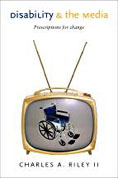October 24, 2005
Audience Problems
A review by Susan M. LoTempio
OK, I admit it. This review was supposed to be filed months ago. I missed my deadline and it's not a case of "the dog ate my homework."
 Disability & the Media: Prescriptions for Change Charles A. Riley II. University Press of New England, 2005. Softcover, 244 pages. $26. |
But after reading Charles A. Riley II's tome that attempts to explain why disability gets such lousy treatment in the media, I was left absolutely wordless.
I agonized over how to review a book that had such promise, yet failed so completely. What could I say beyond the fact that it should have been much, much better?
So I spent time again combing through the chapters, examining Riley's theses and research, which made writing this review take even longer, and put me in an even deeper funk. But, still, Dear Reader, we must ask the question: Exactly how did Riley mess up with Disability & the Media: Prescriptions for Change?
Oh, let me count the ways -- but first let's get some things on the record:
Full Disclosure No 1: I am a member of the media that Riley blasts from here to eternity in these 200-plus pages of analytical venom. I've been in the newspaper "biz" for more than 30 years, and I participate on panels that educate reporters and editors on improving their coverage of people with disabilities.
Riley is described on the book jacket as a "newsroom veteran" who was a reporter for Fortune magazine and an editor of Art & Auction magazine. He is now, according to his book bio, an associate professor of English at Baruch College/City University of New York.
I suspect he is most known as the co-founder of WeMedia and editor-in-chief of WE, a national disability lifestyle magazine that's no longer being published.
Full Disclosure No. 2: I never read WE magazine and wasn't aware of WeMedia. I'd bet Riley never heard of any of my work either.
Full Disclosure No. 3: I am a wheelchair user.
In the preface, Riley writes, "I do not have a disability, and in the eyes of some, as well as within the framework of my story, this poses a problem."
Some would agree with his statement, others might disagree. I choose to focus on other issues, leaving his qualifications for others to judge.
One obvious issue that needs to be discussed, though, is whom did he write this book for?
In the writing classes I teach at Medaille College in Buffalo, NY, students spend a great deal of time discussing the importance of determining "audience" for a piece of writing. Riley must have skipped that lesson, and that's a mortal blow for the effectiveness of his book.
Let's examine this a bit:
Could the audience be disability media activists? (There's nothing here they don't already know.)
Perhaps, the audience is members of various media outlets? (I personally don't know many who would take the time or have the inclination to read through all this ponderous posturing.)
Is it for college journalism students? (Only if their professors tested them on the contents.)
Is it written for those who want the inside story about what happened at WeMedia/WE magazine? (That would be one of my guesses.)
Or, perhaps, audience and purpose are intertwined to fulfill the old college adage: publish or perish.
Whatever reason Riley had for writing this book, and whatever promises his publisher saw in it, its lack of focus makes a mess of his message.
Riley's expertise is spread pretty thin as he analyzes the disability subtext in every media from advertising to movies and television, to (rather surprisingly) "The Use and Abuse of the Disability Memoir," to the Internet, and of course, to mainstream media's failure to portray the true disability experience.
Basically, his theory is that all forms of media have paid more attention to disability in the last decade or so because of people like Michael J. Fox, Christopher Reeve and Steven Hawking. However, the attention paid to these celebrities isn't getting the media to look deeper into disability issues, but rather to focus even more on the medical/cure, inspirational and "overcoming" the disability type of stories. Boil all this down and, as Riley points out, the media is playing the pity card.
He'll get no argument from me about that. Still, I was exhausted trying to follow the "conspiracy theories" he sees hampering disability coverage in all these diverse areas. In the end, I gave up trying.
I also got tired of the name-dropping, the insinuation that he knows what goes on inside places like The New York Times and The New Yorker, and the overriding tone of "I'm the expert."
My theory is that Riley's book is a thinly veiled attempt to set the record straight about WeMedia and WE magazine. References to his experiences in these enterprises are annoyingly scattered throughout the book, usually not serving any purpose I can see other than a cleansing of the soul.
Unfortunately, there are no truly meaningful "Prescriptions for Change" as the subtitle promises, unless you count one appendix on guidelines for portraying people with disabilities in the media; and another on Web accessibility, both unnecessary since that information can be found elsewhere.
For those of us who toil in the media biz every day, and see a critical need for improving coverage of disability issues, Riley seems ponderously out of touch.
What a shame.
Susan LoTempio is an assistant managing editor at The Buffalo News, Buffalo, NY. She writes about disability and participates in seminars around the country on how media cover disability issues.
Posted on October 24, 2005